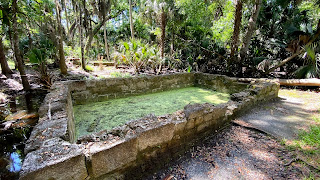Sinking Sites: Bulow Plantation
When I pulled my car up to the ruins of Bulow Plantation, I looked at my friend in the passenger seat and said, "Did we just find a Game of Thrones set?" While it was not a Game of Throne set (which I was just a tad disappointed about), the ruins of the once-bustling sugar plantation have quite the story to tell. The original owner of the site was John Russell, who kept it only for a short time before dying and leaving it to his heirs. They sold it to Charles Bulow in 1821. Charles died only two years after buying the property, adding more to the Game of Thrones vibe of this place. When Charles' son John Bulow took over the planation, the property consisted of 4,675 acres, including the main house the Bulows lived in, the sugar factory; a barn; corn, gin, and poultry houses; a cooperage; a blacksmith; and 40 cabins that were meant to house 300 enslaved people. Because of the abundance of wealth and prosperity that the sugar plantation had, it was nicknamed Bullowville.
So what happened to this place for it to be in ruins? The short answer is that it was burned down in 1836 during the Second Seminole War. The Seminoles burned it down as they fought for their home against a major military campaign to push the tribe out of Florida and into Oklahoma by (surprise surprise) President Andrew Jackson.
Ok, I know you are all anticipating the regular questions of how is this place threatened, why we should protect it, and why should you care, so I will get onto that. Climate change does not rest for any place, including Bulow Plantation. When it was operating, the land was cultivated for major agriculture, but now it is essentially a swamp. The foundations of the spring house and surrounding area behind the main factory ruins are now standing in murky water due to shifting hydrology and sea level rise. This greatly threatens not only accessibility to the site for the general public, but also threatens the site itself due to the fragile nature of the coquina blocks that the ruins are constructed from. So why should you care? You should care because Bulowville sits a a great intersection of history in the United States. It was a testament to the profitability of American Industry due to the labor of 300 people who were captive and forced to do grueling work. It also saw the acts of resistance of the native communities fighting to stay in their homeland during the horrific years of the Trail of Tears. Bulowville is a place that all eyes of history have looked upon, so we must protect it and tell its story so we never forget.
Explore the site virtually via our 3D point cloud of the sugar factory!
Words and text by Emily Hulet, FPAN Intern.




